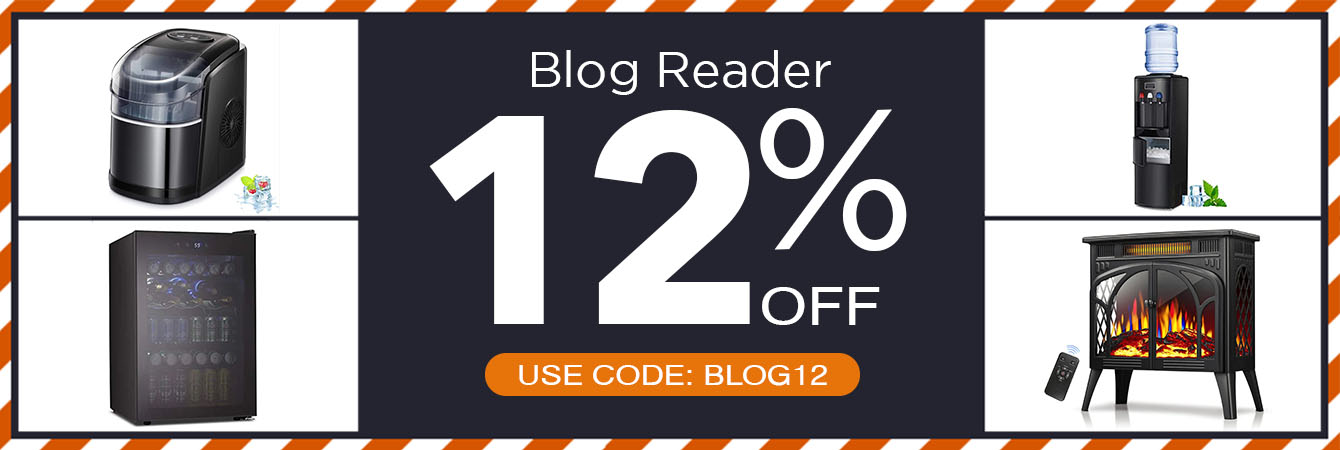How Does A Portable Ice Maker Work?
Your portable ice maker is a clever little thing. Using water from its internal reservoir, a container is filled with water and super-cooled by metal bars. These bars have been loaded with coolant to turn the water into ice.
Next comes the really cool bit. Once the ice is made, the bars warm up to melt the area of ice surrounding them. This causes the blocks to fall into the ice bucket at the bottom.

Et voila! You have refreshing ice ready in a moment to cool down that beverage on a warm summer’s day.
But what else do you need to know about ice makers? Let’s start with the components involved in your appliance.
What Are The Main Components Of Your Ice Maker & What Do They Do?
- Water reservoir
- Ice making tray
- Evaporator
- Thermostat
- Compressor
- Condenser
- Expansion water valve or inlet valve
As we said earlier, the water reservoir is there to store your water in its liquid state. As the coolant in the metal barbs freezes the water, the compressor then starts to apply pressure on the coolant turning it into a hot gas.
When the ice drops, the condenser dissipates the hot gas. At this point, the inlet valve releases the pressure on the compressor and allows the barbs to cool again.
Meanwhile, the evaporator works to ensure the internal temperature of your machine remains low throughout the process.
It’s also worth mentioning that your ice maker is not a freezer. There is a distinction here because if you don’t use your ice when it falls into your storage bucket, it will melt into the reservoir again for the next cycle.
How Long Does It Take For A Portable Ice Maker To Make Ice?
The time it takes for your portable ice maker to make ice depends on a number of things. However, it shouldn’t take around 12 minutes to make 10 cubes.
Although, several factors will affect the time it takes for your machine to make ice and the quality of the cubes once they’re ready.
A couple of main external issues to be aware of are:
- Water quality and temperature
- Climate and temperature
Water Quality
Water quality plays a huge role in your machine's ability to function smoothly. This is why you should always aim to fill your machine with distilled water rather than straight from the tap.

The minerals from the faucet's water cause limescale to build up on some of the components we outlined above and slow your production time.
This is even more problematic in locations like Wisconsin, Indiana, Florida, and Texas, as these states have harder water than others.
Additionally, you should consider the water temperature you’re putting into your reservoir. The colder the water, the faster your ice will be made.
Climate
Another external factor that can affect the speed of your ice creation is the temperature. If it’s hot in your ice maker's room, then it will need to work harder to create the ice.

Similarly, if the room is too cold, it can be difficult for the prongs to warm up and melt the ice into the tray.
To ensure the best results from your machine, storing it in a location with a fairly consistent daily temperature is best.
Do You Need To Add Water To A Portable Ice Maker?
Because this is a portable ice maker, you must manually pour water into the reservoir to begin freezing.
Countertop or fixed ice machines feature water lines plumbed directly into your supply. However, you can’t move them around the home or take them away with you.
But remember, when adding water to your machine, consider water quality and temperature. Using chilled bottled water is your best bet.
What To Consider When Buying A Portable Ice Maker
There are a number of things to consider when buying a portable ice maker. Including:
- Reservoir size
- Freeze speed
- Cube size
- Energy efficiency
- Maintenance
Reservoir Size
Most portable machines boast an onboard reservoir of around 2.2 liters. This will allow for approximately 26 pounds of ice to be created every 7-15 minutes.
Freeze Speed
Ensure you get a machine that delivers a freeze time of around 10-12 minutes. Any shorter than that, and it may start using too much power, while longer wait times just aren't convenient.
Cube size
Larger cubes will take longer to produce fewer cubes in each cycle. So ensure you have your maker set to smaller cubes.

Energy Efficiency
The average ice maker energy use is around 350 kWh per month. This equates to around $21 a month. But you can obviously lower this by using it less.
Maintenance
Your machine will need regular maintenance to ensure it continues to work at its best. It pays to follow the steps for cleaning your portable ice maker regularly and don’t overwork it.
Final Thoughts
Your portable ice maker uses an incredible mixture of compressors, condensers, valves, and evaporators to deliver cooling ice cubes on the go.
Providing you have a power outlet and the ability to keep it covered; you can buy your portable ice maker with Kismile and create ice from anywhere you like. Perfect for entertaining or just making the most of those sunny afternoons in the yard.




















